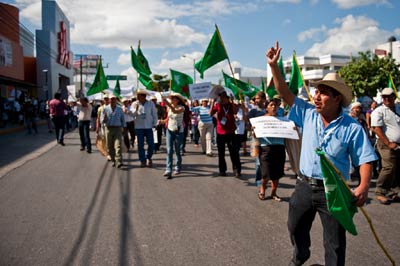Tiempo Climate Cyberlibrary
Cancún Sets Important Adaptation Processes into Motion
- Tiempo archive
- Complete issues
- Selected articles
- Cartoons
- Climate treaty
- Latest news
- Secretariat
- National reports
- IPCC
About the Cyberlibrary
The Tiempo Climate Cyberlibrary was developed by Mick Kelly and Sarah Granich on behalf of the Stockholm Environment Institute and the International Institute for Environment and Development, with sponsorship from the Swedish International Development Cooperation Agency.
While every effort is made to ensure that information on this site, and on other sites that are referenced here, is accurate, no liability for loss or damage resulting from use of this information can be accepted.
 |
Sven Harmeling argues that, as far as adaptation is concerned, the Cancún Climate Summit was a small step in the right direction. |
| The author is senior advisor on climate and development with Germanwatch. | |
The Cancún Climate Summit resulted in the adoption of a comprehensive set of decisions addressing many aspects of the climate debate. It must be seen as a milestone on a long journey that will continue to be hard and dusty. Amongst other outcomes, the Cancún Adaptation Framework was adopted. This agreement marks an important intermediate step in the adaptation negotiations, which started in Bali in 2007 and which during the Copenhagen Climate Summit progressed more than many other building blocks of the United Nations Framework Convention on Climate Change (UNFCCC) negotiations.
The Cancún Adaptation Framework covers a range of aspects, from principles guiding adaptation action to a list of activities which countries can undertake under this umbrella, from the need to strengthen regional cooperation to the invitation to multiple stakeholders to contribute to the implementation of the framework. During the negotiations in Cancún, it was mostly those issues with a concrete operational relevance that were most controversial and absorbed most of the adaptation negotiating time. At the end, negotiators arrived at some conclusions that can have impact on the ground.
For Least Developed Countries (LDCs), it was decided to establish a process which assists them in their national adaptation planning efforts, for example, if they want to develop national adaptation plans or comprehensive climate change strategies. Building on the experience of the National Adaptation Programmes of Action, the UNFCCC will support through the preparation of guidelines and the facilitation of exchange of experience.
 |
|
Demonstrators marching in Cancún to demand
negotiators achieve a fair deal against climate
change
© Ainhoa Goma/Oxfam |
An Adaptation Committee was established to promote coherence on adaptation under the Convention. There was a long struggle between developed and developing countries over the functions that should be pursued as well as on the question of whether such a committee would be the right approach to perform these functions. Only when negotiations went to the ministers' level could agreement be reached.
The need to address loss and damage - those impacts that remain unaddressed despite best mitigation and adaptation efforts - was highly controversial. The Alliance of Small Island States (AOSIS) has promoted an international mechanism to address loss and damage from extreme as well as from slow-onset events, such as sea-level rise. The mechanism was supposed to include insurance approaches as well as aspects of compensation and rehabilitation. In the end, Parties agreed to elaborate a work programme on several issues connected to loss and damage, which, although less than demanded by AOSIS, must be seen as a decision in favour of the most vulnerable countries. The issue will be kept on the political agenda, even if it is only a first step towards actions on this problem.
A key problem was solved which has, for a long time, hindered serious action on adaptation under the Convention, the issue of adaptation to the so-called "response measures". This refers to adaptation to the adverse effects of emission mitigation actions, when, for example, Organization of the Petroleum Exporting Countries perceive loss in revenues because developed countries reduce their oil consumption as a result of their climate policies. Unfortunately, the Convention connects both aspects - adaptation to climate change impacts and to response measures - in one article. As always when there was the attempt to scale-up action on adaptation, Saudi Arabia and other oil producers demanded to benefit from adaptation actions as well. Clearly, it is immoral to put the losses from the reduction in harmful activities on an equal footing with the impacts of climate change on the most vulnerable who largely bare no responsibility for the problem in the first place. The Copenhagen Accord failed in separating response measures from adaptation to climate impacts. Cancún, however, achieved the outcome that response measures are dealt within the mitigation section, and not as part of adaptation.
Partially, the decisions in Cancún already shape the debates for the next climate summit, the 17th Conference of the Parties to the climate treaty in December 2011 in Durban, South Africa. For example, the modalities for the Adaptation Committee as well as the LDC support process will have to be worked out during 2011, with a view to agree on operationalization in Durban. With regard to the work programme on loss and damage, it was agreed that Parties and relevant organizations can make submissions by February 21st to the UNFCCC Secretariat on the elements to be included in the work programme, which will end at the 18th Conference of the Parties in 2012.
Of course, in the end, all this will not be sufficient to save vulnerable countries and people if it is not underpinned by strong financial support from developed countries, and if the world's largest emitters, in particular, developed countries, do not step up their mitigation ambition. In both regards, the Cancún Climate Summit was only a small step forward, but a step in the right direction nevertheless.
Further information
Sven Harmeling, Germanwatch eV, Büro Bonn Dr Werner-Schuster-Haus Kaiserstr 201, D-53113 Bonn, Germany. Fax: +49-228-6049219. Email: harmeling@germanwatch.org. Web: www.germanwatch.org.
On the Web
Germanwatch has published a briefing paper on the adaptation negotiations. The Cancún agreement on long-term cooperative action, which covers adapation and other topics, is available on-line. The Tiempo Climate Cyberlibrary lists selected websites covering adaptation.
Bright Ideas

General Electric plans to cut solar installation costs by half

Project 90 by 2030 supports South African school children and managers reduce their carbon footprint through its Club programme

Bath & North East Somerset Council in the United Kingdom has installed smart LED carriageway lighting that automatically adjusts to light and traffic levels

The United States National Oceanic and Atmospheric Administration and the American Public Gardens Association are mounting an educational exhibit at Longwood Gardens showing the link between temperature and planting zones

The energy-efficient Crowne Plaza Copenhagen Towers hotel is powered by renewable and sustainable sources, including integrated solar photovoltaics and guest-powered bicycles
El Hierro, one of the Canary Islands, plans to generate 80 per cent of its energy from renewable sources

The green roof on the Remarkables Primary School in New Zealand reduces stormwater runoff, provides insulation and doubles as an outdoor classroom

The Weather Info for All project aims to roll out up to five thousand automatic weather observation stations throughout Africa

SolSource turns its own waste heat into electricity or stores it in thermal fabrics, harnessing the sun's energy for cooking and electricity for low-income families

The Wave House uses vegetation for its architectural and environmental qualities, and especially in terms of thermal insulation

The Mbale compost-processing plant in Uganda produces cheaper fertilizer and reduces greenhouse gas emissions

At Casa Grande, Frito-Lay has reduced energy consumption by nearly a fifth since 2006 by, amongst other things, installing a heat recovery system to preheat cooking oil
Updated: May 15th 2015